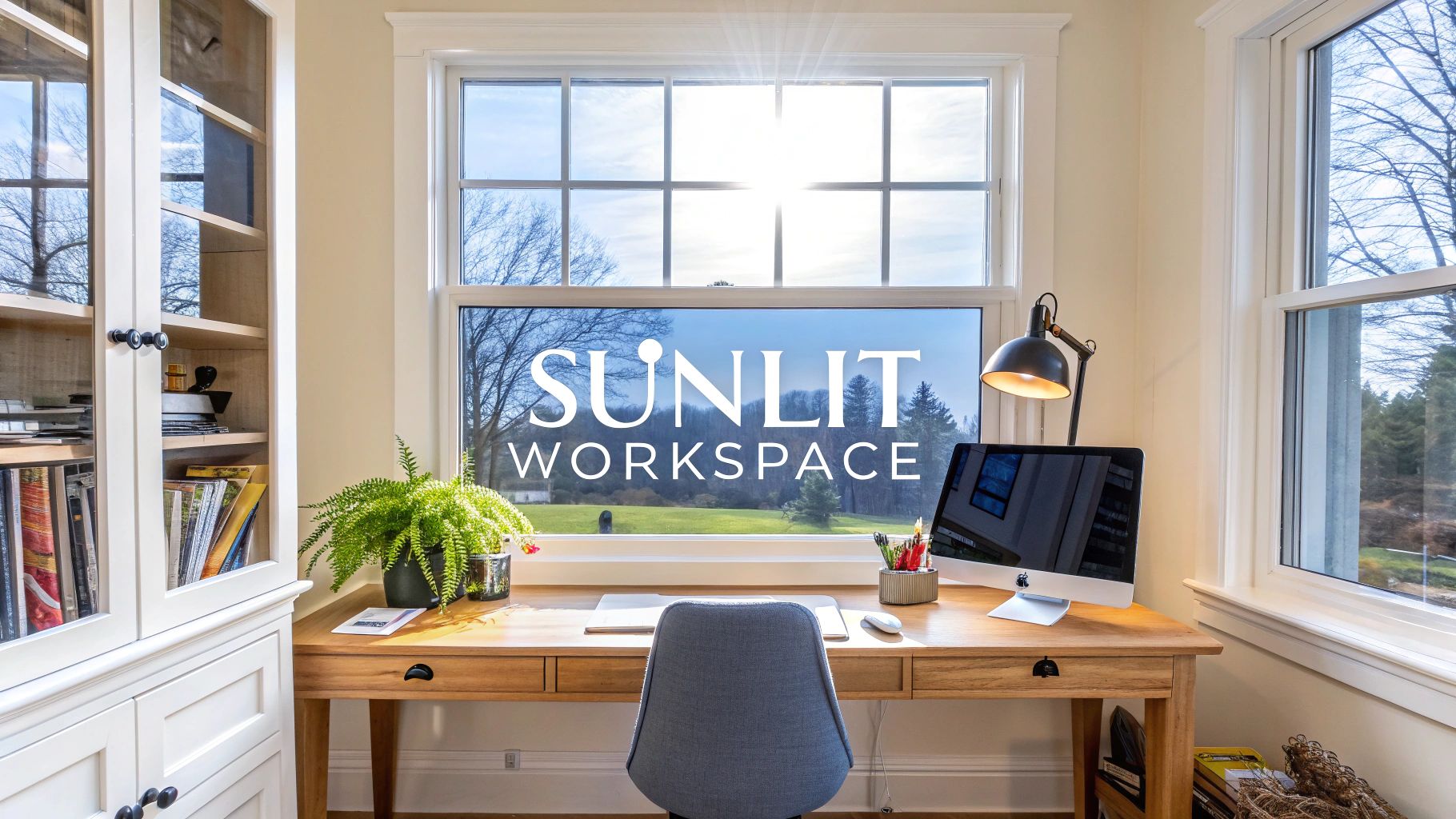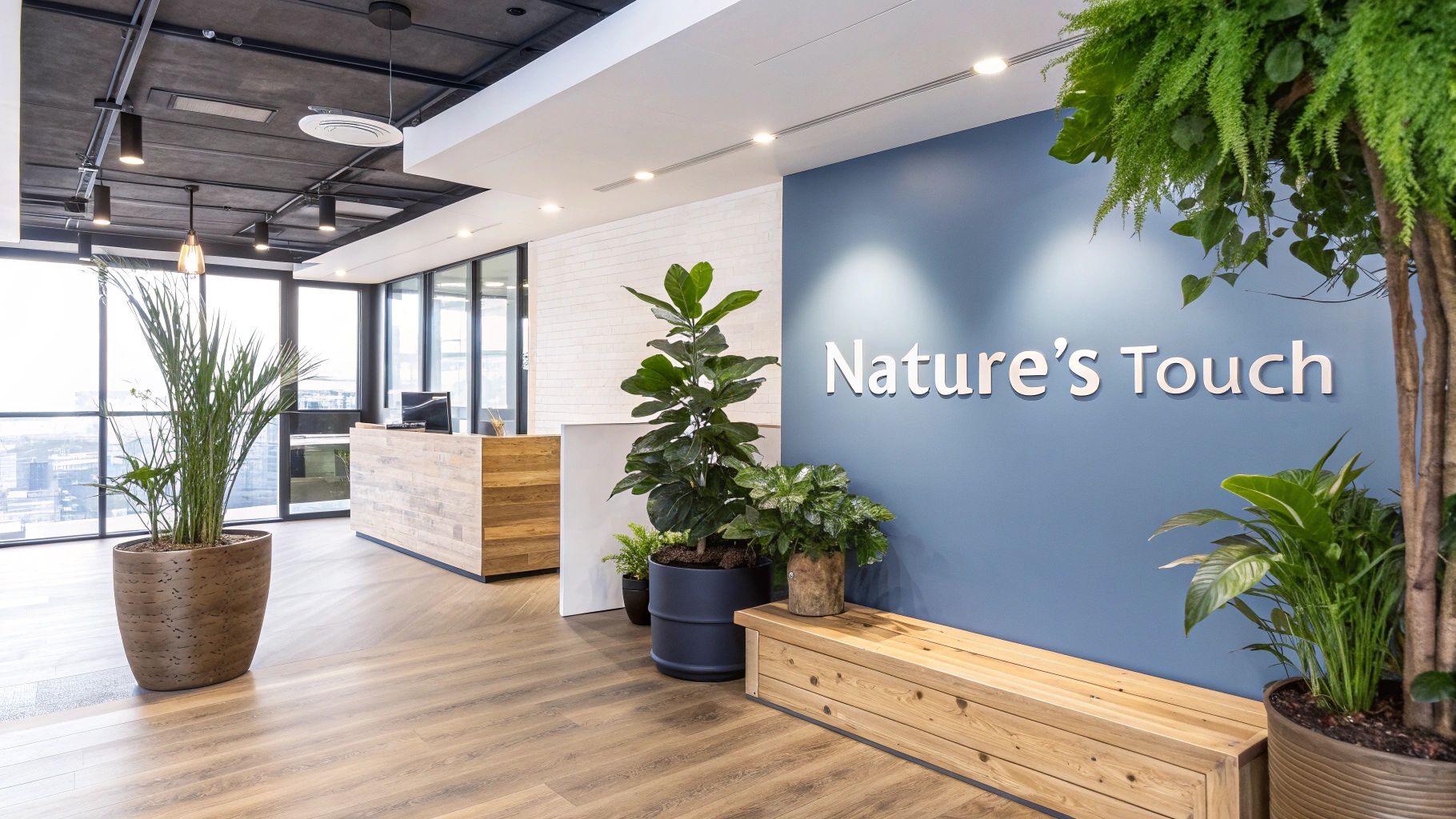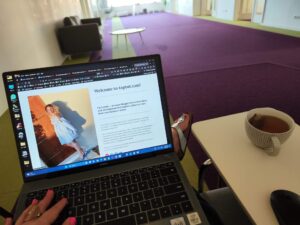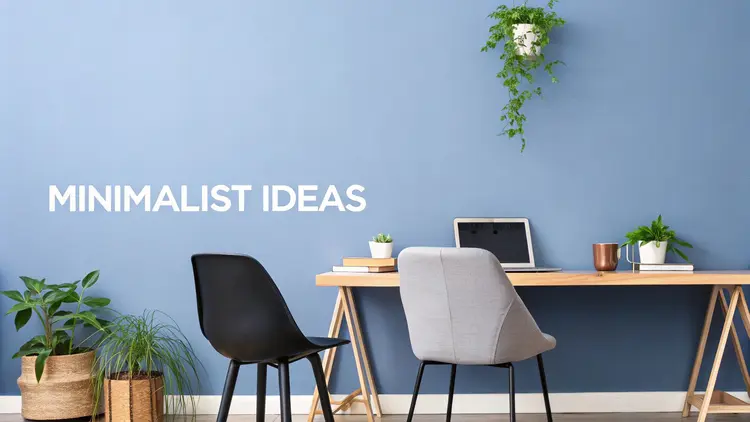Is your home office more distracting than empowering? A cluttered desk, scattered papers, and messy cables can crush creativity rather than nurture it. For professionals who work from home – especially those with ADD – having a minimalist workspace isn’t just about aesthetics, it’s key to staying focused and productive.
This approach draws from minimalist art and Zen teachings, removing unnecessary elements to highlight what truly matters: concentration, practicality, and smooth workflow. It’s like decluttering your physical environment to clear your mental space. The minimalist movement emerged in the mid-20th century, celebrating the power of simplicity – ideas that now shape everything from design to daily life. The concept works because our surroundings directly affect our mental state. A clean, organized space helps create a clear mind, leading to better focus, less stress, and more creativity.
We’ll explore the essential principles of creating a minimalist home office that boosts your productivity instead of hindering it. Rather than jumping into product recommendations, we’ll start by building a thoughtful foundation for organizing your workspace effectively. You’ll discover practical ways to embrace minimalism and turn your office into a space that sparks efficiency and inspiration. Whether you love planning with bullet journals, geek out over productivity tools, or just want to simplify your space, you’ll find concrete tips to streamline your workflow and sharpen your focus.
1. Clean Desk Policy: Your Foundation for a Minimalist Home Office
A minimalist home office starts with the basics – a clean desk. Beyond just looking nice, it’s a proven way to reduce distractions and improve focus.
The Clean Desk Policy is simple: keep only what you need right now and store everything else away.
This approach has been successfully used by professionals ranging from Marie Kondo to tech executives who need to maintain peak performance.

Picture this: you sit down to work and instead of seeing piles of papers and old coffee cups, you find a clean, clear space ready for your next task. That’s the magic of keeping a tidy desk – it helps you jump right into your work without visual distractions getting in the way. Here’s what makes a Clean Desk Policy work:
- Only essential items on the desk: Keep out just what you need for your current task
- Neat cable management: Use cable organizers to prevent messy wires
- End-of-day cleanup: Take 5 minutes to reset your workspace
- Everything has its place: Assign specific spots for important items
Why This Matters: For anyone dealing with distractions or ADD, or just wanting to work better, a clean desk makes a real difference. It’s not about perfectionism – it’s about creating a space that helps you focus.
Benefits:
- Better focus: A clear desk helps create a clear mind
- Fewer distractions: Less stuff means less to pull your attention away
- Simple to maintain: Basic setups are easier to keep tidy
- Reduced stress: An organized space helps you feel calmer
Challenges:
- Needs daily upkeep: You have to stick with it every day
- Can feel too bare: Some people prefer a more lived-in space
- Storage needed: You’ll need places to keep non-essential items
Tips to Get Started:
- Clear your desk each evening: Make it a daily habit
- Use drawer organizers: Keep small items sorted and easy to find
- One day’s work at a time: Only keep out what you need today
- Go digital when possible: Save papers as files instead
Want more tips? Check out these Home Office Organization Tips for extra ideas on managing cables, storage, and creating a workspace that works for you. Starting with a clean desk is just the beginning – it sets you up for better focus and more productive workdays.
2. Monochromatic Color Scheme
A minimalist home office works best when it embraces simplicity and focus. One of the most effective ways to create this peaceful workspace is through a monochromatic color scheme. By using a limited palette of neutral tones, you can create a calming atmosphere that helps you stay focused and productive. This approach is especially helpful for entrepreneurs with ADD, content creators, and anyone looking to boost their productivity.
By using a limited palette of neutral tones, you can create a calming atmosphere that helps you stay focused and productive. This approach is especially helpful for entrepreneurs with ADD, content creators, and anyone looking to boost their productivity.
The beauty of a monochromatic scheme lies in its simplicity. Start with neutral base colors like white, gray, beige, or black. Instead of bold color contrasts, use different textures to add depth and interest. Picture a crisp white office with sleek black accents – this creates visual appeal while keeping the space harmonious. You might also consider a grayscale palette or soft, natural tones inspired by Scandinavian design.
This design choice offers several key benefits. The visual harmony helps create a sense of calm and order – perfect if you tend to accumulate digital clutter. It’s a classic look that won’t go out of style, making it a smart long-term choice. Plus, it’s easy to maintain and update – just swap out a few accessories in the same color family to refresh the space. Most importantly, it reduces visual stress, which is great for bloggers and bullet journal enthusiasts who spend lots of time at their desk.
Just keep in mind that a monochromatic scheme needs careful planning. Without the right balance, it can feel cold or lack personality. The key is finding the sweet spot between minimalism and personal style.
Here’s how to create your own monochromatic office:
- Pick your main neutral color: This sets the foundation. White, gray, and beige work well.
- Add texture variety: Include woven rugs, linen curtains, or wooden furniture to create visual interest.
- Consider one accent color: Used sparingly in artwork or accessories to add personality.
- Incorporate natural elements: Wood, stone, and plants blend beautifully with neutral tones.
For more insights on how colors affect productivity, check out Design for Success: The Secret of Colors in the Office.
Whether you’re running a solo business, creating content, or just want a focused workspace, a monochromatic color scheme can make a real difference. By creating a visually calming environment, it helps you stay focused and productive while keeping your space clean and uncluttered.
3. Multi-functional Furniture
Maximizing every inch of space is vital for a minimalist home office. Multi-functional furniture helps create an organized workspace while maintaining a clean, uncluttered look. This approach works especially well for entrepreneurs with ADD, solo business owners, and content creators who need versatile spaces. Learn more about the core benefits of this minimalist approach in this helpful guide: 12 Universal Benefits of Minimalism.https://www.youtube.com/embed/ABQcNz2hDJo
Multi-functional furniture creates an adaptable environment that grows with your needs. Picture a desk that folds away after work to reveal a cozy seating area, or an ottoman that stores files and supplies. These smart solutions help you stay productive without cluttering your space with single-purpose items.
The demand for clever, space-saving furniture continues to grow as more people embrace minimalism and efficient small-space living. Companies like IKEA, Resource Furniture, and West Elm offer innovative designs perfect for modern lifestyles. Resource Furniture’s wall beds transform living rooms into bedrooms instantly, while IKEA’s storage solutions help create flexible workspaces.
Real-world example: A solopreneur working from a small apartment uses a wall-mounted fold-down desk that disappears after hours. Their expandable dining table serves as both a meeting space and everyday eating area.
Key Features:
- Convertible designs: Pieces that adapt to different uses
- Built-in storage: Hidden organization solutions
- Modular components: Easily customizable pieces
- Space-saving mechanisms: Maximize floor space
Benefits:
- Makes the most of available space
- Smaller furniture footprint
- Cost-effective long-term
- Adapts as needs change
Potential Drawbacks:
- Higher upfront costs than basic furniture
- May not match specialized furniture performance
- Some pieces can be heavy or complex
Smart Implementation Tips:
- Check build quality: Look for sturdy construction that handles regular use
- Think ahead: Choose pieces that will work for future needs
- Try before buying: Test all moving parts and mechanisms
- Measure carefully: Double-check dimensions for proper fit
You might find this helpful: [Tips for Creating a Minimalist Workspace]. Multi-functional furniture helps create a focused, efficient home office that supports your work style. By choosing quality pieces that match your needs, you’ll build a workspace that boosts productivity while maintaining minimalist simplicity.
4. Digital Organization System
A minimalist home office needs more than just a clean desk and hidden cables – it needs a clear digital environment that helps you focus. When your digital world is organized, you can work more efficiently and maintain the peaceful atmosphere you’ve created in your physical space.

Cloud storage and smart software have made it easier than ever to keep your digital life tidy. Remember when desks were covered in paper files and sticky notes? Now you can access your entire work library from your phone. This shift to paperless systems has become essential for anyone managing multiple projects, especially entrepreneurs and small business owners.
A good digital organization system includes these key elements:
- Cloud Storage: Use services like Google Drive, Dropbox, or OneDrive to access files from anywhere
- Clear File Names: Create a naming system (like YYYYMMDD-Project-Document) to find files quickly
- Digital Documents: Scan papers and use note-taking apps to reduce physical clutter
- Smart Scheduling: Connect your calendar with task apps to track deadlines and projects in one place
Benefits:
- No more overflowing file cabinets
- Find any file in seconds with search
- Help the environment by using less paper
- Work from anywhere with internet access
Challenges:
- Need basic tech knowledge
- Reliable internet required
- Takes time to set up initially
Popular Tools:
- Google Workspace: Complete suite with Drive, Docs, Calendar
- Evernote: Perfect for notes and web clipping
- Notion: Customizable workspace for tasks and wikis
Tips to Get Started:
- Create clear file naming rules that make sense to you
- Set regular times to clean up digital files
- Use automatic cloud backups
- Make logical folder structures that match your workflow
For more guidance on digital organization: [How to Create a File Naming System You’ll Actually Stick With] and [Organizing Your Digital Files: A Step-by-Step Guide]. Get additional tips here: https://loreleiweb.com/digital-file-organization-system/
A well-organized digital system does more than boost productivity – it helps create the focused, peaceful workspace you’re aiming for. With the right tools and habits, you can build a digital environment that supports your minimalist goals.
5. Natural Light Optimization
Light has a remarkable influence on our work environment. Research shows that good natural lighting boosts focus, mood, and productivity while helping create a more pleasant workspace that feels open and uncluttered – perfect for a minimalist home office.
Getting the most from natural light comes down to smart setup choices. Position your desk near windows, use light-colored walls and furniture that reflect light well, and keep window coverings minimal. Even something as simple as adding a strategically placed mirror can make your space feel brighter and more open.
The science backs up the benefits. Studies show that natural light exposure improves both mood and productivity, plus it helps reduce energy costs from artificial lighting. For anyone doing video calls or content creation, good natural lighting also makes you look much better on camera. As a bonus, it makes spaces feel larger and less confined.
More people are prioritizing natural light in their home offices, especially since remote work became widespread. The shift highlighted just how important a bright, comfortable workspace is for wellbeing and productivity. This has led to growing interest in design approaches that maximize daylight, from glass walls to Scandinavian-inspired bright and airy spaces. Check out more remote work tips in our guide on How to Work From Home During Quarantine.
Of course, natural light comes with some challenges to consider. Screen glare can be distracting, room temperature may fluctuate, and privacy can be a concern for street-facing offices.
Here are practical ways to make the most of natural light while avoiding common issues:
- Use adjustable window coverings: Light-filtering blinds or sheer curtains let you control brightness and privacy
- Position screens carefully: Keep monitors perpendicular to windows to prevent glare
- Add an anti-glare screen: This helps reduce eye strain during long workdays
- Choose light colors: White or pale furniture and walls help bounce light around the room
For entrepreneurs managing ADHD, solo business owners, and content creators focused on productivity, optimizing natural light can make a real difference. These simple tips help create a bright, energizing minimalist workspace that supports focus and creativity while promoting wellbeing. Natural light becomes not just a design choice but a practical tool for getting more done. Combined with other productivity techniques like bullet journaling, it helps create an ideal environment for focused work.
6. Vertical Storage Solutions

Want to make the most of your limited home office space? Vertical storage is your secret weapon for keeping your workspace tidy and organized. By using your walls effectively, you can create a clean, open environment that helps boost focus and productivity – especially helpful if you have ADD or simply want a minimalist workspace.
As living spaces get smaller and minimalism grows in popularity, smart vertical storage has become a must-have solution. Wall-mounted shelves, floating desks, and pegboard systems let you store everything you need without making your office feel cramped or cluttered.
Key Features:
- Wall-mounted shelves: Perfect for storing books, files, and decorative items
- Floating desks: Create more floor space while maintaining a modern look
- Pegboard systems: Customize your storage for tools and supplies – great for content creators
- Vertical file holders: Keep documents organized and easy to access
Main Benefits:
- More open floor space: Creates a roomier, more comfortable workspace
- Added visual style: Makes your office more appealing and dynamic
- Flexible organization: Adjust storage to match your workflow
- Easy access: Keep frequently used items within reach
Things to Consider:
- Installation needs: Basic DIY skills and tools required
- Wall care: Proper mounting prevents damage
- Space limits: Storage depends on available wall area
Real Examples:
- IKEA ALGOT: An affordable modular system you can customize for your space
- Custom floating shelves: Built to match your style and exact storage needs
- Grid organizers: Popular with bloggers and creators for displaying supplies and creating inspiration boards
Setup Tips:
- Use proper anchors to mount everything securely
- Plan your layout carefully before installing
- Choose adjustable systems that can grow with your needs
- Space items evenly to maintain visual balance
Vertical storage does more than just save space – it helps create the calm, organized environment that’s essential for productivity. Whether you’re a digital minimalist or solo business owner, making smart use of your walls can completely transform your workspace.
7. Biophilic Elements: Bringing the Outdoors In
Creating a minimalist home office isn’t just about clean lines and empty surfaces. Adding natural elements can make your workspace both beautiful and energizing. Biophilic design – incorporating nature into indoor spaces – helps boost focus, reduce stress, and spark creativity. This approach works especially well for entrepreneurs with ADD, solo business owners, and content creators who need an inspiring yet calming environment.
The concept stems from the biophilia hypothesis – our natural human instinct to connect with nature. This design style has roots in Japanese and Scandinavian aesthetics, which emphasize organic materials and peaceful environments – perfect elements for a modern minimalist office.
Ready to add some natural touches? Start with easy-care plants like snake plants that clean your air without needing constant attention. Add bamboo desk organizers for natural texture, or choose a desk with beautiful wood grain to ground your space visually.
Key Features and Benefits:
- Easy-care plants: Clean your air, lower stress, create visual interest
- Natural materials: Add warmth through wood, bamboo, and stone elements
- Organic shapes: Balance hard minimalist lines with gentle curves
- Natural textures: Engage your senses with varied surfaces
Advantages:
- Better air quality: Plants naturally filter toxins and boost oxygen
- Less stress: Research shows even small doses of nature lower stress hormones
- More creativity: Natural elements help stimulate new ideas
- Nature connection: Creates calm that helps with focus, especially for ADD
Potential Challenges:
- Plant care needs: Even low-maintenance plants need basic care (try self-watering planters!)
- Allergies: Some people may react to certain plants/materials
- Material costs: Natural wood and stone can cost more than synthetics
Quick Tips for Adding Nature:
- Pick hardy indoor plants: Snake plants, ZZ plants, pothos thrive in offices
- Use self-watering containers: Keep plants healthy with less effort
- Add wooden elements: From full desks to small accessories
- Mix shapes: Combine clean minimalist lines with organic curves
Natural elements turn a basic minimalist office into a living space that supports both productivity and peace. By thoughtfully adding these touches, you’re creating an environment that helps you focus, create, and feel your best. This balanced approach particularly helps entrepreneurs and creators optimize their workspace for success.
8. Cable Management System
A messy desk with tangled cables can really hurt your focus, especially if you have ADD or want a clean minimalist office space. Beyond just looking bad, loose cables can be dangerous to walk around and collect dust. That’s why a good cable management setup is essential for creating a clean, functional workspace that helps you stay productive.
Cable management goes beyond just hiding wires behind your desk. It’s about thoughtfully organizing your tech connections while keeping them accessible when needed. This involves using tools like under-desk trays, cable clips, ties, wireless devices where possible, and hidden power strips to reduce visible clutter.
Features and Benefits:
- Cable Routing Tools: Keep cables off the floor with under-desk trays, desk leg clips, and cable sleeves to bundle wires together neatly
- Wireless Options: Switch to wireless keyboards, mice, printers, and chargers to cut down on cable mess
- Hidden Power: Mount power strips under your desk or in drawers to conceal bulky plugs
- Cable Organization: Use velcro ties and organizers to neatly group cables together
Pros:
- Clean Look: Your workspace instantly looks tidier and more appealing
- Safety: No more tripping over loose wires
- Easy Cleaning: Dusting is simple without cables in the way
- Professional: An organized desk looks great on video calls and content
Cons:
- Setup Time: Takes effort to set up initially
- Product Costs: Quality cable management tools can be pricey
- Less Flexible: Changing your setup means redoing cable organization
Real Examples:
Check out communities like r/battlestations to see amazing cable management in action. These setups show how smart cable routing with trays, custom solutions and wireless gear creates super clean workspaces. Even minimalist setups prioritize clean cable management.
Tips for Getting Started:
- Label Everything: Mark cables clearly – you’ll thank yourself later
- Use Velcro: Choose velcro ties over zip ties for easy changes
- Plan Routes: Map out cable paths before starting to avoid tangles
- Buy Quality: Good cable management products are worth the investment
Taking time to manage your cables properly can transform a chaotic desk into an organized space that helps you work better. For anyone wanting a minimalist, productive home office, it’s definitely worth the effort.
8-Point Minimalist Home Office Design Comparison
| Title | 🔄 Complexity | ⚡ Resources | 📊 Outcomes | ⭐ Advantages | 💡 Tips |
|---|---|---|---|---|---|
| Clean Desk Policy | Daily maintenance, habit formation required | Minimal items, basic organizers | Enhanced focus and a calm workspace | Reduced clutter and distractions | Enforce clear-desk end-of-day; use drawer organizers |
| Monochromatic Color Scheme | Requires careful balance of tones | Neutral palette materials | Cohesive, calming aesthetic | Timeless look and reduced visual stress | Mix textures and add one accent color |
| Multi-functional Furniture | Complex selection & testing of mechanisms | Higher-cost investment in quality pieces | Maximized space with versatile use | Adaptable design and cost-effective in long run | Test functionality; measure space carefully |
| Digital Organization System | Technical setup for digital workflows | Cloud storage and specialized software | Streamlined workflow and easy access | Paperless efficiency and remote accessibility | Use consistent file naming; schedule regular declutter |
| Natural Light Optimization | Simple adjustments with some precision | Strategic window placement and light furniture | Enhanced mood with energy savings | Open feeling and productivity boost | Use adjustable blinds and anti-glare screens |
| Vertical Storage Solutions | Moderate DIY installation and planning | Utilizes wall space and mounting tools | Maximizes floor space and organized areas | Customizable look with visual interest | Plan layout beforehand; use proper wall anchors |
| Biophilic Elements | Low to moderate care and upkeep | Investment in plants and natural materials | Improved air quality and reduced stress | Connection to nature and enhanced creativity | Choose low-maintenance plants; balance shapes |
| Cable Management System | Detailed routing and initial setup time | Specialized accessories and cable trays | Cleaner, safer, and professional workspace | Reduced hazards and enhanced appearance | Label cables; prefer velcro ties over zip ties |
Creating Your Ideal Minimalist Workspace
A clean and simple home office does more than just look good – it helps you focus and unleash your creativity. By embracing key elements like a tidy desk, simple color scheme, smart furniture choices, digital organization, natural lighting, vertical storage, plants, and hidden cables, you can build a workspace that powers your productivity.
Making your workspace minimalist is a personal journey. Begin with what matters most to you – maybe a clutter-free desk helps you think clearly, or adding greenery brings calmness. Feel free to test different approaches and adapt. This is especially true for entrepreneurs with ADD, who often need customized solutions. Take time to evaluate what’s working: Are there still messy spots? Is your digital filing system doing its job? Keep refining until your space truly supports your work style.
As minimalism continues to grow, technology is becoming more seamless in our workspaces. Modern solutions like wireless charging pads, under-desk cable management, and smart lighting help create cleaner, distraction-free environments that work better. These tools can take your minimalist office to the next level.
Key Takeaways:
- Less is More: Removing clutter helps clear your mind
- Functionality is Key: Choose versatile, multipurpose items
- Personalization is Crucial: Adapt principles to your needs
- Continuous Improvement: Regularly assess and update your space
Looking for guidance on building a focused, productive business as an entrepreneur with ADD? Lorelei Web offers practical strategies, real-world insights, and proven techniques to help you cut through complexity and achieve results. From organizing your digital life to optimizing your daily workflow through journaling and mind mapping, you’ll find resources to build a thriving business while maintaining clarity. Learn more at Lorelei Web.

Lorelei has been an online entrepreneur, marketer and writer since 2006. Her biggest passion is WordPress, which is why she switched to being a full-time blogger 20 years ago and hasn’t looked back since. With so many years of experience behind her, she is an expert in copywriting, SEO, marketing and business strategies.






